

Barbarism or Barbarism?
Creativity Thinking. Creativity and Spirit. Creativity and Education. Creativity & Diversity. Knowing. Creativity & Intuition. Creativity & Uncertainty. Creativity & Emotion. Creativity & Patterns. Creativity and Courage, Failure. Creative Traits. Uncovered Gem: Steve Jobs on Paul Rand. By Maria Popova A brave assault on the paradox of choice, or why the best option is the only option.
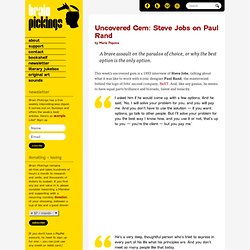
This week’s uncovered gem is a 1993 interview of Steve Jobs, talking about what it was like to work with iconic designer Paul Rand, the mastermind behind the logo of Jobs’ second company, NeXT. And, like any genius, he seems to have equal parts brilliance and bravado, talent and tenacity. I asked him if he would come up with a few options. And he said, ‘No, I will solve your problem for you, and you will pay me. He’s a very deep, thoughtful person who’s tried to express in every part of his life what his principles are.
A wonderful companion read — a 1990 interview with Rand on what he calls “the play instinct”, echoed and evolved in a couple of our favorite TED talks, Tim Brown’s and Paula Scher’s. Donating = Loving Bringing you (ad-free) Brain Pickings takes hundreds of hours each month. You can also become a one-time patron with a single donation in any amount: Share on Tumblr. Schopenhauer on Style. By Maria Popova “Truth that is naked is the most beautiful, and the simpler its expression the deeper is the impression it makes.”

What does it mean to write with style? For Kurt Vonnegut, it was about keeping it simple yet interesting. How 17 Equations Changed the World. By Maria Popova What Descartes has to do with C.
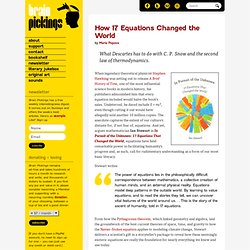
P. Snow and the second law of thermodynamics. When legendary theoretical physicist Stephen Hawking was setting out to release A Brief History of Time, one of the most influential science books in modern history, his publishers admonished him that every equation included would halve the book’s sales. Undeterred, he dared include E = mc², even though cutting it out would have allegedly sold another 10 million copies. Stewart writes: The power of equations lies in the philosophically difficult correspondence between mathematics, a collective creation of human minds, and an external physical reality.
Greek stamp showing Pythagoras's theorem But the case for why we should even care about equations — and mathematics, and science in general — goes back much further. Snow later added: So how did equations begin, anyway? An equation derives its power from a simple source. The original coinage appeared as follows: Donating = Loving Share on Tumblr. Xl6PzGy. Herman Melville on Art. By Maria Popova On the mystical mastery of wrestling with the angel.
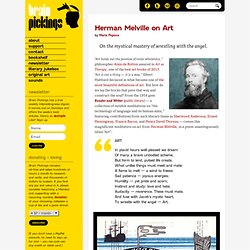
“Art holds out the promise of inner wholeness,” philosopher Alain de Botton assured in Art as Therapy, one of the best art books of 2013. “Art is not a thing — it is a way,” Elbert Hubbard declared in what became one of the most beautiful definitions of art. But how do we lay the bricks that pave that way and construct the soul? From the 1954 gem Reader and Writer (public library) — a collection of notable meditations on “the technology of language and its human aims,” featuring contributions from such literary titans as Sherwood Anderson, Ernest Hemingway, Francis Bacon, and Henry David Thoreau — comes this magnificent meditation on art from Herman Melville, in a poem unambiguously titled “Art”: ARTIn placid hours well-pleased we dream Of many a brave unbodied scheme.
Illustration by Matt Kish from 'Moby-Dick in Pictures.' Donating = Loving Bringing you (ad-free) Brain Pickings takes hundreds of hours each month. Ted Hughes on the Universal Inner Child, in a Moving Letter to His Son. The 13 Best Psychology and Philosophy Books of 2013. By Maria Popova How to think like Sherlock Holmes, make better mistakes, master the pace of productivity, find fulfilling work, stay sane, and more.
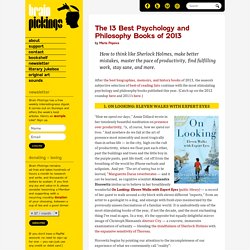
Debunking the Myth of the 10,000-Hours Rule: What It Actually Takes to Reach Genius-Level Excellence. By Maria Popova How top-down attention, feedback loops, and daydreaming play into the science of success.
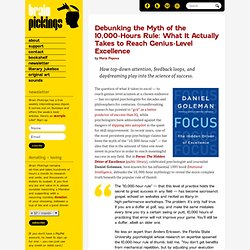
The question of what it takes to excel — to reach genius-level acumen at a chosen endeavor — has occupied psychologists for decades and philosophers for centuries. Groundbreaking research has pointed to “grit” as a better predictor of success than IQ, while psychologists have admonished against the dangers of slipping into autopilot in the quest for skill improvement.
In recent years, one of the most persistent pop-psychology claims has been the myth of the “10,000-hour rule” — the idea that this is the amount of time one must invest in practice in order to reach meaningful success in any field. But in Focus: The Hidden Driver of Excellence (public library), celebrated psychologist and journalist Daniel Goleman, best-known for his influential 1995 book Emotional Intelligence, debunks the 10,000-hour mythology to reveal the more complex truth beneath the popular rule of thumb: Stories for Navigating Change - Journalism That Matters. How can journalists discern what stories are most useful for helping us navigate through turbulent times?
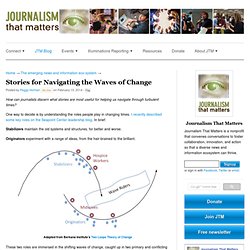
One way to decide is by understanding the roles people play in changing times. I recently described some key roles on the Seapoint Center leadership blog.